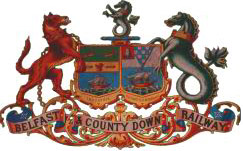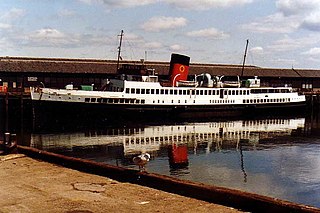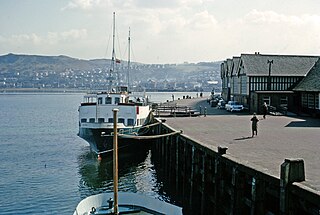
The Holy Loch is a sea loch, a part of the Cowal peninsula coast of the Firth of Clyde, in Argyll and Bute, Scotland.

PS Waverley is the last seagoing passenger-carrying paddle steamer in the world. Built in 1946, she sailed from Craigendoran on the Firth of Clyde to Arrochar on Loch Long until 1973. Bought by the Paddle Steamer Preservation Society (PSPS), she has been restored to her 1947 appearance and now operates passenger excursions around the British coast.

The Belfast and County Down Railway (BCDR) was an Irish gauge railway in Ireland linking Belfast with County Down. It was built in the 19th century and absorbed into the Ulster Transport Authority in 1948. All but the line between Belfast and Bangor was closed in the 1950s, although some of it has been restored near Downpatrick by a heritage line, the Downpatrick and County Down Railway.

The Clyde steamer is a passenger service on the River Clyde in Scotland, running from Glasgow downstream to Rothesay and other towns, a journey known as going doon the watter.

William Denny and Brothers Limited, often referred to simply as Denny, was a Scottish shipbuilding company.

The Caledonian Steam Packet Company provided a scheduled shipping service, carrying freight and passengers, on the west coast of Scotland. Formed in 1889 to complement the services of the Caledonian Railway, the company expanded by taking over rival ferry companies. In 1973, they were merged with MacBraynes as Caledonian MacBrayne.

MV Balmoral is a vintage excursion ship owned by MV Balmoral Fund Ltd., a preservation charity. Her principal area of operation is the Bristol Channel, although she also operates day excursions to other parts of the United Kingdom. The Balmoral is included on the National Historic Ships register as part of the National Historic Fleet.
Fleming and Ferguson was a Scottish marine engineering and shipbuilding company that traded between 1877 and 1969.

TSMV Shanklin was a passenger ferry that operated between Portsmouth and the Isle of Wight between 1951 and 1980. Renamed Prince Ivanhoe she went on to become a pleasure cruiser in the Bristol Channel but in 1981 sank off the Welsh coast on her first season.

TS King Edward was an excursion steamer built at Dumbarton for service down the River Clyde to the Firth of Clyde and associated sea lochs on the west coast of Scotland, as far as Campbeltown. The first commercial vessel to be driven by steam turbines, King Edward was remarkably successful for a prototype, serving as a Clyde steamer for half a century from 1901 until 1951, interrupted only by service in the two world wars. The success of the vessel quickly led to the adoption of turbine propulsion for all manner of merchant vessels, from channel ferries and coastal steamers to transatlantic liners.

MV Maid of Argyll was a passenger ferry operated by Caledonian Steam Packet Company, initially based at Craigendoran. Rendered redundant by the car ferry revolution, she was sold to Greek owners in 1975. She caught fire in 1997 and was left to decay.
PS Glen Rosa was a 306 GRT passenger paddle steamer that J&G Thomson launched in 1893 for the Glasgow and South Western Railway (G&SWR). She served with the Royal Navy in the First World War as HMS Glencross. She was absorbed into the London, Midland and Scottish Railway fleet in 1923, transferred to the Caledonian Steam Packet Company in 1938 and scrapped in 1939.
PS Slieve Donard was a United Kingdom passenger paddle steamer that in different periods of her history was also called PS Albion and HMS Albyn. Albion is the name she bore the longest and may be the one by which she is better known in England. Slieve Donard was her original name and the one by which she will be best known on the island of Ireland.
This page describes the shipping services of the Glasgow and South Western Railway.
HMS Snaefell was a paddle steamer, built at John Brown & Company's Clydebank shipyard for the Barry Railway Company and launched on 1907 as the PS Barry. Built to serve as a pleasure steamer carrying passengers on the Bristol Channel, she was quickly transferred to the ownership of Bristol Channel Passenger Boats which in 1911 became part of P & A Campbell.
PS Waverley was a Clyde-built paddle steamer that carried passengers on the Clyde between 1899 and 1939. She was requisitioned by the Admiralty to serve as a minesweeper during World War I and again in World War II, and was sunk while participating in the Dunkirk evacuation in 1940. The current PS Waverley, launched in 1946, was built as a replacement for this vessel.

PS Eagle III was a passenger-carrying paddle steamer that was built and sailed on the Clyde, and was twice requisitioned by the Admiralty to serve as a minesweeper during the world wars.
PS Waverley was a Clyde-built paddle steamer that carried passengers on the Clyde between 1885 and 1887, then on the Bristol Channel from 1887 until 1916 when she was requisitioned by the Admiralty to serve as a minesweeper during World War I.











